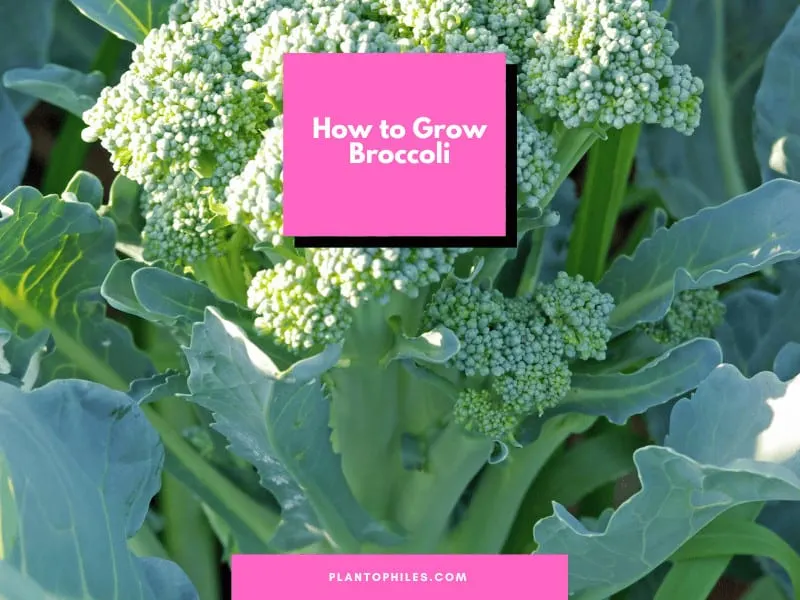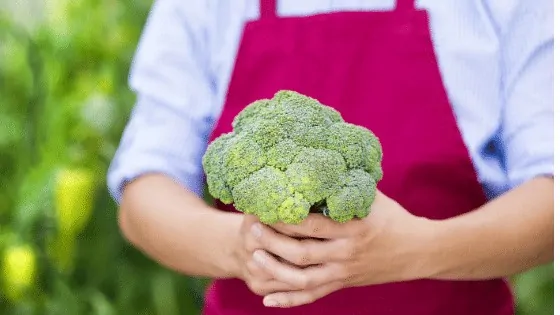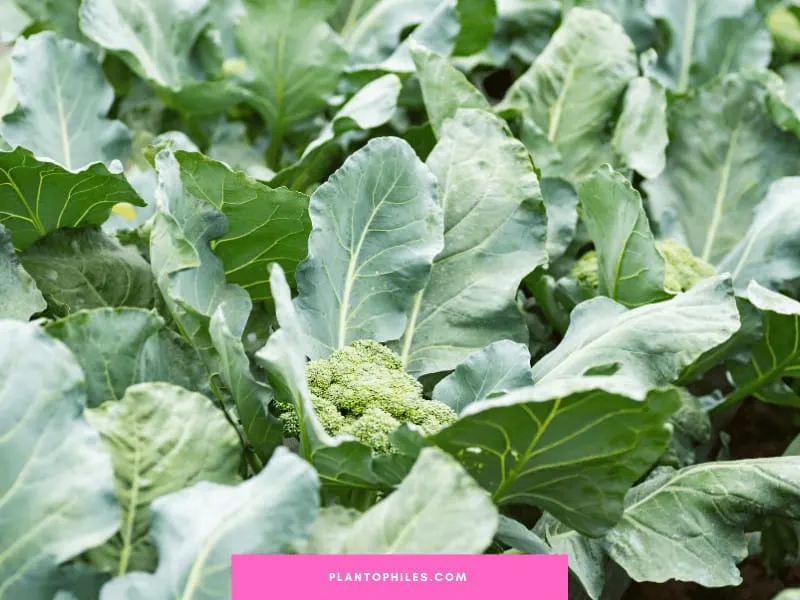How to Grow Broccoli – Broccoli or Brassica oleracea var. italica is a healthy green member of the cabbage family and is closely associated with Brussels sprouts, cauliflower, and cabbage. Best grown in the spring and fall, broccoli is a cool-season crop that loves sunny conditions.
When planted under appropriate conditions, it is observed to give two main harvests, followed by several mini harvests every growing season. But have you ever tried to grow broccoli in your garden or asked your fellow gardening enthusiasts how to grow broccoli?
Here’s a comprehensive guide to plant, growing, and harvesting broccoli in your vegetable garden.
Broccoli Care Takeaways
| Species | Brassica oleracea var. italica |
| Synonyms | Broccoli, Italian broccoli, Calabrese |
| Family | Brassicaceae |
| Genus | Brassica |
| Growth | Clumping, upright |
| Height | 2 feet |
| Width | 2 feet |
| Soil | Well-draining soil rich in organic matter |
| Watering | Every 7-10 days |
| Light | Full sun |
| Temperature | 50-75 °F (10-24 °C) |
| Humidity | 40-60% |
| Fertilizer | Fertilize monthly in spring and summer |
| Propagation | Seed or transplanting |
| Planting | Plant in spring or summer |
Broccoli is a favorite vegetable to plant among gardeners. I love growing it because it is highly nutritious.
Get to know everything about how to grow broccoli before taking the plunge and start planting, as the most common mistakes can be easily avoided, and essential tips and tricks can be taken aboard.
Table of Contents
How to Grow Broccoli
To grow broccoli, use a well-draining soil mix that retains water well. Choose a spot that provides at least 6-8 hours of sunlight daily. Plant broccoli in early spring or late summer. When planting, space broccoli 16 – 18 inches (40-45cm).

How much Sunlight does Broccoli need
Broccoli needs 6-8 hours of full sun exposure.
Soil
The soil must be well-draining with high moisture retention quality and rich in organic matter. It should be slightly acidic with a pH ranging from 6.0 to 6.8.
Fertile soil with ample organic matter ensures a readily available supply of essential nutrients for healthy growth. Boron is one such micro-nutrient essential for broccoli. Any signs of deficiency in boron lead to a hollow formation of broccoli stems.
Broccoli spacing in raised beds
When planting broccoli in raised beds, each broccoli plant should be spaced at a distance of 16 – 18 inches (40-45cm).
If gardening in rows, ensure that the transplants are 18 – 22 inches (45-55cm) apart within each row, while the distance between each row should range between 24- 36 inches (61-91cm).
When to Plant Broccoli
The ideal planting time for broccoli is either early spring or late summer, making it a cool-season crop. It is recommended that the broccoli plantation should be ready for harvesting before temperatures hit 75 degrees Fahrenheit and above. The aim is to prevent high summer temperatures from stunting the growth of broccoli by allowing it to mature early.
In areas that experience mild winters, broccoli seeds can be started indoors in late summer months and later own, as autumn approaches, you can set them in the garden. This will prepare the crop ready for harvesting in winter.
Extreme weather conditions cause broccoli to seed affecting the formation of heads and florets. For regions that have cold weather conditions with short seasons, broccoli must be started in summer for harvesting in fall.

How to Plant Broccoli
A good how to grow broccoli guide also needs to go into how to plant broccoli. Planting broccoli is comparatively simple than most other vegetables.
If you plan to start outdoors, sow seeds at a depth of ½ inches (1.3cm), with each seedling at least 3 inches apart. As soon as the seedlings reach a height of 3 inches (7.6cm), you will have to start the process of thinning them, as this will allow the plants to be 15 – 20 inches apart (38-51cm).
Similarly, if you have started the seeds indoors, plant these 4- 6 weeks old transplants with a few leaves (at least 4 – 5).
These transplants should be at a distance of 12 – 20 inches (30-50cm) and depth slightly deeper than the height of their original container.
Also, make sure that you plant seeds and transplants at the same time for a continued harvest, mid-season varieties can be planted together.
Watering
Watering the broccoli plantation regularly is crucial. Keep track of your watering cycle, as broccoli grows best in moist and well-nourished soil. It would help if you also worked in mulch to help control weeds and retain soil moisture at all times.
Fertilizing
Broccoli needs a lot of nutrients, says the University of Georgia. Fertilize it monthly during the growing season using an NPK fertilizer high in phosphorus and potassium, such as NPK 5-10-15.
They also need sufficient nitrogen to grow well. Nitrogen can be provided in the form of blood meal.
Broccoli Maintenance and Care
It is important to take care of the broccoli plant to facilitate growth.
- Water and feeding cycles must be followed strictly. Keep the soil moist at all times during the growing season. Broccoli plants must be watered at the base of the plant. Regularly water at least 1 to 1 ½ inches (2.5-3.8cm). You must provide consistent soil moisture, especially in severe drought conditions.
- And then gradually reduce the water supply as plants begin to mature. As the broccoli plants mature, keeping the ground moist and not soggy is essential. Mulch application can also help retain moisture while keeping the ground cool as the temperature gets hot. Therefore, it helps keep the soil temperature desirable for nourished growth.
- Additionally, in the maturation phase, the plants can be side dressed by boosting vegetable fertilizers. Spread the fertilizer across the stems without touching them. This will increase the flow of nutrients while improving moisture retention.
- Broccoli plants need high amounts of nitrogen or blood meal to nurture growth. If the soil is nitrogenless, the leaves might run pale yellow, gradually affecting the entire plant.
- Fertilize broccoli every three weeks after you have transplanted the seeds in the garden. Low nitrogen fertilizer is a favorite pick.
- Keep mulch ready and suffocate weeds using a generous amount of mulch.
- To minimize pests, you must use row covers.
- Make use of a garden trowel occasionally to loosen the soil, as it will help in the removal of weeds that tend to harbor pests.
- Good air circulation in well-drained soil makes it healthy, and that, in turn, makes it less susceptible to pest attacks and diseases.
These maintenance care tips should give you a good indication of what how to grow broccoli consists of.
Harvesting Broccoli
For amateur gardeners or first-time growers, figuring out the ideal harvesting time for most green vegetables, especially those in the Brassica oleracea family, might be tedious.
There won’t be any immediate color transition to signal that the plant is ready to be harvested.
The broccoli plants are set for the first harvest when you notice the heads have been formed. The diameter of these heads will usually fall in a range of 4-7 inches (10-17cm).
The recommended time to harvest is early morning, as the bud heads are considered tight and firm.
However, if you notice any yellow leaves around the plant, you must harvest them immediately because there are chances that the taste and quality might be on the verge of depletion.
The right way to harvest is to make an angular cut through the heads of each plant. This will allow excess water to drain away, preventing the heads from rotting. It will also nurture side-shoot production for successive harvests.

Common Problems and Pests for Broccoli
Pest problems in broccoli are similar to cabbage—ranging from cabbage worms to root maggots to aphids.
In the initial phase of the planting season, these pests are seriously troublesome. At the same time, diseases include black rot and clubroot. One popular and effective way to control the disease is the timely practice of crop rotation.
- Aphids – If you notice the leaves shrinking with curling at the edges, you should know they are attacking it. To remove this insect, apply soap and water to the leaves.
- Club Root – It is a commonly found infection in plants from the Brassicaceae family. A fungal infection penetrates the roots, causing them to swell up and distort, leading to stunted growth. Clubroot tends to affect the soil when it’s moist and warm. To prevent clubroot attacks, maintain the soil pH, and make sure the soil is always drained.
- Cabbage loopers are small caterpillars that eat away leaves, leaving holes behind – If you notice any such small holes in the leaves, look under the leaves for the green caterpillar. You can use bacterial pesticides to control cabbage loopers. But if there are only a few loopers, you should handpick them instead. You can also make use of row covers after you plant the seedlings and take it off when the harvesting time is there.
- Down Mildew – Yellow-colored patches on the leaves result from moist weather conditions. Make sure that you keep the leaves dry with constant air circulation.
- Blackleg – is a common fungal disease that leaves broccoli encircled in a clustered and causes the soil to rot. The common sources of blackleg are cutworms and cabbage maggots. This disease can be tackled by removing infected plants and ensuring the garden has debris-free ground. You should also add organic matter to planting beds while keeping the soil bed well-drained.
Growing Broccoli Hydroponically
Broccoli can be grown hydroponically. Cocopeat, rock wool, or leca balls can be used as a growing medium. In a hydroponic system, no soil is used, and the nutrients come from the water.
Suitable hydroponics systems for broccoli are NFT, Ebb and Flow, or Kratky.
When planting form seeds, use two seeds per cell, as not every Broccoli seed will sprout. If you are growing in cocopeat, slightly cover the seeds with peat.
Keep the medium slightly humid and warm. After five days, germination usually starts.
The strength of the nutrient solution(TDS) should be around 250ppm for the seedlings.
The ideal pH is 5.5-6.5.
After around 14 days, the first true leaves appear, and you can increase the ppm level slightly every week or so.
After 3-4 weeks, it is time to transfer your seedlings to the hydroponics system and transplant them into net cups.
I prefer growing broccoli in leca (hydroton balls).
After around 65 days, broccoli flowers start emerging.
Read more about what plants are best for hydroponics.
Broccoli Companion Plants
The best Broccoli companion plants are:
- Spinach
- Beets
- Beans
- Cucumbers
- Carrots
- Onions
- Dill
- Radishes
- Basil
Read more about the best broccoli companion plants.
Frequently Asked Questions
What type of soil does broccoli need?
Broccoli plants require rich yet well-drained soil. Mix a few inches of well-aged or compost in the soil before planting. A balanced fertilizer will also enrich the soil with essential nutrients. Lastly, the soil pH is the key to growing pleasant-tasting broccoli. The ideal pH of the soil must be between 6.0 – 6.8.
How should I take care of my broccoli plant?
Broccoli is considered a heavy-feeding plant and thus requires timely fertilization. So, ensure that you work in rich compost or well-aged manure at 2-4 inches height before planting commences. This will give the soil the nourishment it needs to grow. The next important tip is to water the plant to maintain healthy moisture levels regularly.
To prevent pests and other diseases, it is stressed that you plant broccoli in areas where you haven’t grown any vegetables from the cabbage family for the last 3-4 years. This concept is generally referred to as crop rotation. And crop rotation in broccoli plants is a must.
When is the best time to harvest broccoli plants?
When the harvesting season approaches, it is important that you closely observe the color of florets. They should be deep green, and that is when you must harvest. Harvest broccoli heads as the buds start to swell for the best quality and pleasant flavor. However, do so before the petals start turning yellow.
How long does it take to harvest broccoli?
Broccoli grown from seeds can be harvested after 100 days. It can also take up to 150 days. Transplants take about 50 days until harvest.
How can we store broccoli after harvesting?
Wash the broccoli thoroughly and leave it to dry completely. Once it is dry, you can store it in the refrigerator. Broccoli can be stored in the refrigerator for 5-6 days. However, if you wish to store it for a long, blanch it in hot water and freeze it in an airtight container; it will last for one year.
Is Broccoli healthy?
Broccoli is crowned as one of the most prominent nutritional vegetables for greens. This powerhouse is home to essential minerals, vitamins, antioxidants, and fibers that are beneficial to human health. It not only controls the development of cancerous cells, but the antioxidant properties help in the prevention of several other medical conditions.
This low-calorie vegetable with a slightly bitter taste profile may not be popular amongst all, but it sure holds a rich nutritional value.
Broccoli is delicious and healthy to eat. Unsurprisingly, many gardeners want to know how to grow broccoli. We hope this guide helped to clarify the most important points and is inspiring you to plant broccoli in your garden yourself.
Or if you already have broccoli planted, this how to grow broccoli article is hopefully a good treasure trove with tips and tricks you can consult. Happy gardening everyone!
Takeaways
To grow broccoli:
- Plant in spring or summer
- Use a well-draining soil mix
- Choose a spot that gets 6-8 hours of direct sunlight
- Space broccoli 16 – 18 inches (40-45cm)

Daniel has been a plant enthusiast for over 20 years. He owns hundreds of houseplants and prepares for the chili growing seasons yearly with great anticipation. His favorite plants are plant species in the Araceae family, such as Monstera, Philodendron, and Anthurium. He also loves gardening and is growing hot peppers, tomatoes, and many more vegetables.


